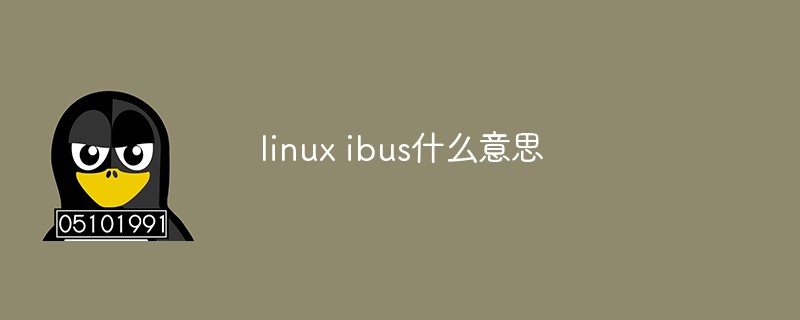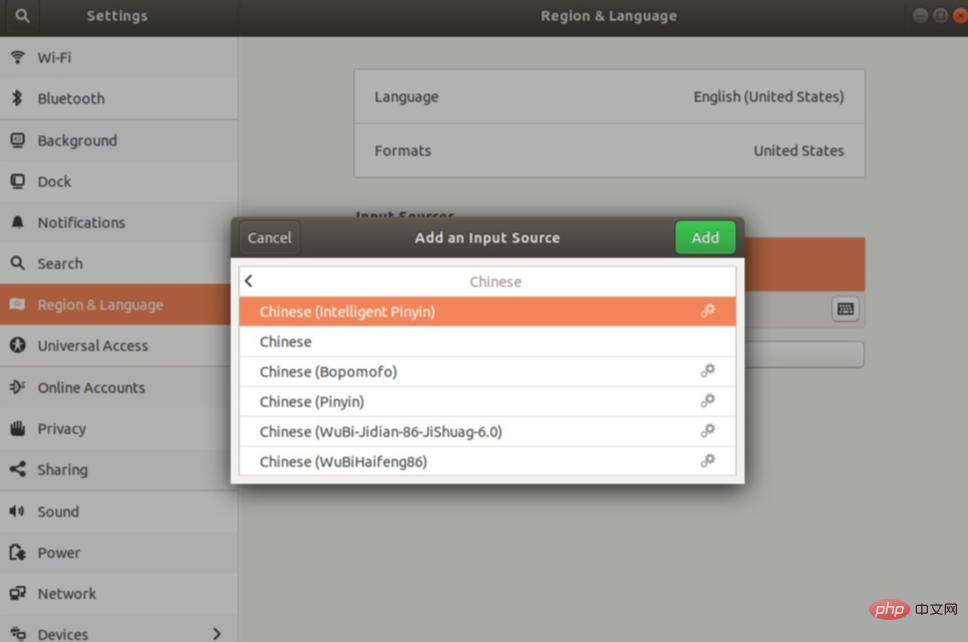What does linux ibus mean?
IBus is an open source free multi-language input method framework that distributes source code under GNU/Linux and UNIX-like operating systems under the GPL agreement; because it adopts a bus (Bus) architecture, it is named Bus . IBus supports multiple input methods, such as Pinyin input method (including Quan/Simplified/Double Pinyin), and supports code table-based input methods, such as Wubi, Zhengma, Erbi, and Cangjie input methods. It is one of several popular GNU /Default non-English input method platform for Linux distributions.

The operating environment of this tutorial: Ubuntu 16.04 system, IBus 1.5.1, Dell G3 computer.
What does ibus mean?
IBus (full name in English is Intelligent Input Bus), which is a type of bus under GNU/Linux and UNIX-like operating systems. Open source free multi-language input method framework with source code distributed under GPL license.
Because it adopts a bus (Bus) architecture, it is named Bus. IBus supports multiple input methods, such as Pinyin input method (including Quan/Simplified/Double Pinyin), and supports code table-based input methods, such as Wubi, Zhengma, Erbi, and Cangjie input methods. It is one of several popular GNU /Default non-English input method platform for Linux distributions (such as Debian, RedHat, etc.).
Install ibus Chinese input method (Linux/Ubuntu)
IBUS is the input framework under Linux. The various input methods within the framework are Ubuntu's default non-English input method. For a newly installed Ubuntu system, if the Chinese environment is selected, after the system is successfully connected to the Internet for the first time, the user will be prompted to download and install the Pinyin and Wubi input code tables under IBUS, but the corresponding input method will not be enabled by default. Let me share my experience in installing and enabling the IBUS Chinese input method.
1. Install the Chinese language pack
The purpose of installing the Chinese language pack is to make the Chinese item appear in Input Sources.
Select "Manage Installed Languages", "Install/Remove Languages", "Chinese(Simplified)", "Apply".

#2. Install the ibus input method
Then you can install the ibus Chinese input method.
Install ibus framework.
sudo apt-get install ibus ibus-clutter ibus-gtk ibus-gtk3 ibus-qt4
Switch to ibus framework.
im-config -s ibus
Install Pinyin engine.
sudo apt-get install ibus-pinyin
3. Add ibus Chinese input method
Add ibus input method to the input method bar.
Now there is Chinese in the Input Source, click on it.

Select Chinese (Intelligent Pinyin).

Select Chinese (Intelligent Pinyin) in the upper right corner. The way to switch between Chinese and English is shift. There are 7 options available in Preferences.
Then you can happily use the ibus Chinese input method.

Related recommendations: "Linux Video Tutorial"
The above is the detailed content of What does linux ibus mean?. For more information, please follow other related articles on the PHP Chinese website!

Hot AI Tools

Undresser.AI Undress
AI-powered app for creating realistic nude photos

AI Clothes Remover
Online AI tool for removing clothes from photos.

Undress AI Tool
Undress images for free

Clothoff.io
AI clothes remover

Video Face Swap
Swap faces in any video effortlessly with our completely free AI face swap tool!

Hot Article

Hot Tools

Notepad++7.3.1
Easy-to-use and free code editor

SublimeText3 Chinese version
Chinese version, very easy to use

Zend Studio 13.0.1
Powerful PHP integrated development environment

Dreamweaver CS6
Visual web development tools

SublimeText3 Mac version
God-level code editing software (SublimeText3)

Hot Topics
 1668
1668
 14
14
 1427
1427
 52
52
 1329
1329
 25
25
 1273
1273
 29
29
 1256
1256
 24
24
 Linux Architecture: Unveiling the 5 Basic Components
Apr 20, 2025 am 12:04 AM
Linux Architecture: Unveiling the 5 Basic Components
Apr 20, 2025 am 12:04 AM
The five basic components of the Linux system are: 1. Kernel, 2. System library, 3. System utilities, 4. Graphical user interface, 5. Applications. The kernel manages hardware resources, the system library provides precompiled functions, system utilities are used for system management, the GUI provides visual interaction, and applications use these components to implement functions.
 vscode Previous Next Shortcut Key
Apr 15, 2025 pm 10:51 PM
vscode Previous Next Shortcut Key
Apr 15, 2025 pm 10:51 PM
VS Code One-step/Next step shortcut key usage: One-step (backward): Windows/Linux: Ctrl ←; macOS: Cmd ←Next step (forward): Windows/Linux: Ctrl →; macOS: Cmd →
 How to check the warehouse address of git
Apr 17, 2025 pm 01:54 PM
How to check the warehouse address of git
Apr 17, 2025 pm 01:54 PM
To view the Git repository address, perform the following steps: 1. Open the command line and navigate to the repository directory; 2. Run the "git remote -v" command; 3. View the repository name in the output and its corresponding address.
 How to run java code in notepad
Apr 16, 2025 pm 07:39 PM
How to run java code in notepad
Apr 16, 2025 pm 07:39 PM
Although Notepad cannot run Java code directly, it can be achieved by using other tools: using the command line compiler (javac) to generate a bytecode file (filename.class). Use the Java interpreter (java) to interpret bytecode, execute the code, and output the result.
 How to run sublime after writing the code
Apr 16, 2025 am 08:51 AM
How to run sublime after writing the code
Apr 16, 2025 am 08:51 AM
There are six ways to run code in Sublime: through hotkeys, menus, build systems, command lines, set default build systems, and custom build commands, and run individual files/projects by right-clicking on projects/files. The build system availability depends on the installation of Sublime Text.
 What is the main purpose of Linux?
Apr 16, 2025 am 12:19 AM
What is the main purpose of Linux?
Apr 16, 2025 am 12:19 AM
The main uses of Linux include: 1. Server operating system, 2. Embedded system, 3. Desktop operating system, 4. Development and testing environment. Linux excels in these areas, providing stability, security and efficient development tools.
 laravel installation code
Apr 18, 2025 pm 12:30 PM
laravel installation code
Apr 18, 2025 pm 12:30 PM
To install Laravel, follow these steps in sequence: Install Composer (for macOS/Linux and Windows) Install Laravel Installer Create a new project Start Service Access Application (URL: http://127.0.0.1:8000) Set up the database connection (if required)
 git software installation
Apr 17, 2025 am 11:57 AM
git software installation
Apr 17, 2025 am 11:57 AM
Installing Git software includes the following steps: Download the installation package and run the installation package to verify the installation configuration Git installation Git Bash (Windows only)




